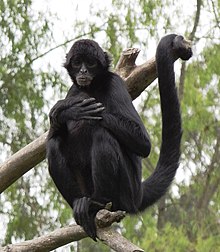The black-headed spider monkey (Ateles fusciceps) is a type of New World monkey, from Central and South America. It is found in Colombia, Ecuador, and Panama.[2] Although primatologists such as Colin Groves (1989) follow Kellogg and Goldman (1944) in treating A. fusciceps as a separate species, other authors, including Froelich (1991), Collins and Dubach (2001) and Nieves (2005) treat it as a subspecies of Geoffroy's spider monkey.[1][3]
| Black-headed spider monkey[1] | |
|---|---|

| |
| Colombian spider monkey at Jaime Duque Park, Cundinamarca, Colombia | |
| Scientific classification | |
| Domain: | Eukaryota |
| Kingdom: | Animalia |
| Phylum: | Chordata |
| Class: | Mammalia |
| Order: | Primates |
| Suborder: | Haplorhini |
| Infraorder: | Simiiformes |
| Family: | Atelidae |
| Genus: | Ateles |
| Species: | A. fusciceps
|
| Binomial name | |
| Ateles fusciceps J. E. Gray, 1866
| |

| |
| Distribution of A. geoffroyi (blue) and A. fusciceps (red) | |
The two subspecies are:[1]
- Ateles fusciceps fusciceps – northwestern Ecuador.[2]
- Ateles fusciceps rufiventris – southwest Colombia to eastern Panama.[2]
Habitat
editA. f. fusciceps lives in tropical and subtropical humid forests between 100 and 1,700 metres (330 and 5,580 ft) above sea level. It lives in population densities of 1.2 monkeys per square kilometer. A. f. rufiventris lives in dry forests, humid forests and cloud forests, and can live up to 2,000 to 2,500 metres (6,600 to 8,200 ft) above sea level.[2]
Description
editA. f. fusciceps has a black or brown body and a brown head. A. f. rufiventris is entirely black with some white on its chin. The black-headed spider monkey is one of the larger New World monkeys. The head and body length, excluding tail, typically ranges between 39.3 and 53.8 cm (15.5 and 21.2 in). The prehensile tail is between 71.0 and 85.5 cm (28.0 and 33.7 in). On average, males weigh 8.89 kilograms (19.6 lb) and females weigh 8.8 kilograms (19 lb). Its brain weighs 114.7 g (4.05 oz).[4]
Diet
editThe Black spider monkey is primarily frugivorous, with the consumption of fruit consisting of about 80% of their diet. the remainder of its diet is omnivorous and consists of leaves, nuts, seeds, bark, insects, and flowers.[2]
Behavior
editThe black-headed spider monkey is arboreal and diurnal. The species is highly sociable, living in social groups with up to 20 individuals but travels in smaller groupings. Most travel is done by brachiating and climbing through woodland areas.[5]
Reproduction
editWhen mating, females may consort with a male for up to three days, or else mate with several males. Mating occurs with the male and female face to face, and can last for five to 10 minutes. The gestation period is between 226 and 232 days. The infant rides on its mother's back for 16 weeks, and is weaned at 20 months. Females attain sexual maturity at 51 months; males at 56 months. Females give birth every three years.[4]
The black-headed spider monkey is considered to be endangered by the International Union for Conservation of Nature (IUCN) due to an estimated population loss of more than 50% over 45 years (2018–2063), from hunting and human encroachment on its range of habitation.[2]
Captive black-headed spider monkeys have been known to live more than 24 years.[6]
Gallery
edit-
Ateles fusciceps rufiventris moving
-
A. f. rufiventris getting something out of the water
References
edit- ^ a b c Groves, C. P. (2005). Wilson, D. E.; Reeder, D. M. (eds.). Mammal Species of the World: A Taxonomic and Geographic Reference (3rd ed.). Baltimore: Johns Hopkins University Press. p. 150. ISBN 0-801-88221-4. OCLC 62265494.
- ^ a b c d e f g Moscoso, P.; Link, A.; Defler, T.R.; de la Torre, S.; Cortes-Ortíz, L.; Méndez-Carvajal, P.G.; Shanee, S. (2021). "Ateles fusciceps". IUCN Red List of Threatened Species. 2021: e.T135446A191687087. doi:10.2305/IUCN.UK.2021-1.RLTS.T135446A191687087.en. Retrieved 19 November 2021.
- ^ Collins, A. (2008). "The taxonomic status of spider monkeys in the twenty-first century". In Campbell, C. (ed.). Spider Monkeys. Cambridge University Press. p. 67. ISBN 978-0-521-86750-4.
- ^ a b Rowe, N. (1996). The Pictorial Guide to the Living Primates. Pogonias Press. p. 113. ISBN 0-9648825-0-7.
- ^ "Black-headed spider monkey". Twycross Zoo. Retrieved 2023-03-15.
- ^ Chapman, C. & Chapman, L. (1990). "Reproductive Biology of Captive and Free-ranging Spider Monkeys" (PDF). Zoo Biology. 9: 6. doi:10.1002/zoo.1430090102.
